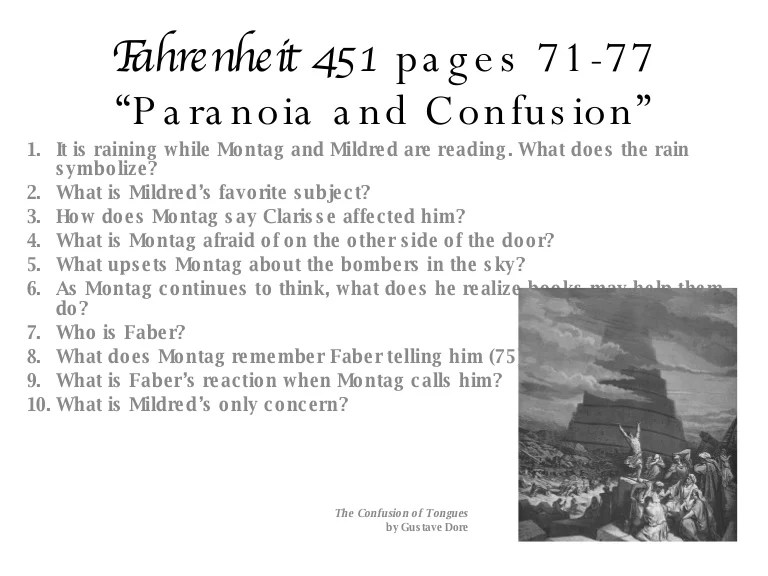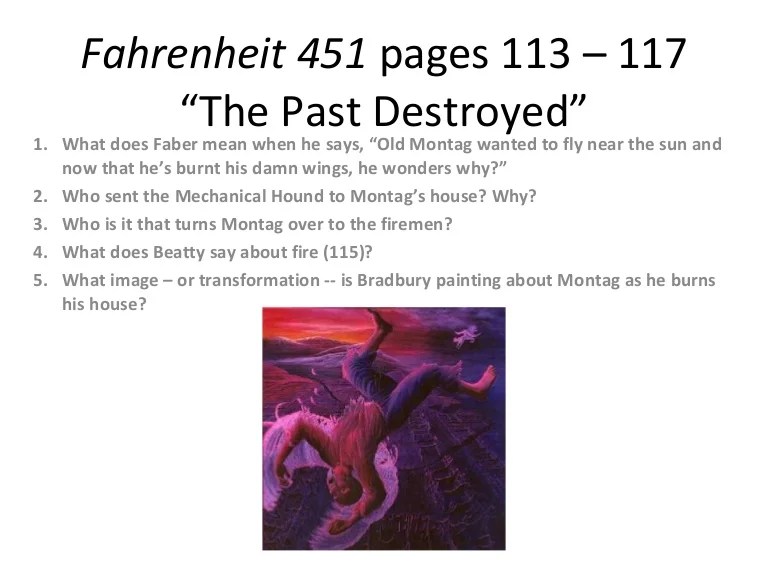Questions for Fahrenheit 451 Part 1: Unraveling Censorship, Knowledge, and Individuality takes readers on a journey through the dystopian world created by Ray Bradbury, where books are outlawed and critical thinking is suppressed. This captivating exploration delves into the novel’s profound themes, examining the significance of literature, the dangers of censorship, and the power of individuality.
Through in-depth analysis of characters, symbolism, and literary devices, this discussion illuminates the novel’s timeless relevance, exploring its insights into the human condition and the enduring struggle against oppression.
Thematic Significance of Books and Knowledge

In Part 1 of Fahrenheit 451, books and knowledge play a pivotal role, serving as symbols of critical thinking, individuality, and resistance against oppressive societal norms.
The suppression of books in the novel represents the suppression of critical thinking and individuality. In a society where books are outlawed, people are deprived of the opportunity to access diverse perspectives and ideas, resulting in a stifled intellectual environment where conformity and ignorance prevail.
Books as a Source of Enlightenment
Books are portrayed as a source of enlightenment, providing individuals with access to knowledge, wisdom, and imagination. They allow people to explore different worlds, expand their understanding, and challenge established norms.
- Guy Montag, the protagonist, initially believes in the government’s claim that books are dangerous and harmful.
- However, as he begins to read and question the status quo, he realizes the transformative power of books and the importance of preserving knowledge.
Books as a Symbol of Resistance
Books also serve as a symbol of resistance against the oppressive regime. By hiding and sharing books, individuals defy the government’s authority and assert their right to think and question.
- Faber, a retired English professor, represents the intellectual resistance against the book-burning society.
- He helps Montag understand the value of books and encourages him to spread the message of their importance.
Character Analysis

Fahrenheit 451 presents a compelling exploration of censorship and the value of literature through its two central characters: Montag, the protagonist, and Beatty, the Fire Chief. This analysis delves into their transformation, motivations, and contrasting views on censorship and knowledge.
Montag’s Transformation
Initially, Montag is a compliant fireman, blindly following orders to burn books. However, exposure to the forbidden literature and conversations with Clarisse sow seeds of doubt within him. His transformation accelerates when he steals a book, igniting a desire for knowledge and understanding.
Through his interactions with Faber and Granger, Montag evolves into a questioning individual, determined to challenge the oppressive society.
Beatty’s Character, Questions for fahrenheit 451 part 1
Beatty, the Fire Chief, is a staunch advocate of censorship and a charismatic yet intimidating figure. He believes that books promote chaos and unhappiness, arguing that “knowledge is power” and must be controlled. Beatty’s motivations stem from a deep-seated fear of the unknown and a desire to maintain the status quo.
His speeches are laced with irony and a perverse enjoyment in burning books, highlighting his misguided beliefs and tragic character.
Contrasting Views on Censorship
Montag and Beatty’s contrasting views on censorship form the core of the novel’s conflict. Montag believes that literature is essential for critical thinking, individuality, and human progress. He argues that burning books is an act of suppressing knowledge and depriving society of its intellectual and cultural heritage.
In contrast, Beatty sees censorship as a necessary evil to protect society from chaos and preserve its stability. He believes that books contain dangerous ideas that can lead to rebellion and societal unrest. Beatty’s arguments reflect the totalitarian nature of the dystopian society, where individual thought and freedom are suppressed in the name of order.
Social Commentary on Censorship and Control

Fahrenheit 451 explores the far-reaching consequences of censorship and its impact on society. In a dystopian future where books are outlawed and firemen are tasked with burning them, the novel unveils the insidious methods employed by the government to control information and suppress dissent.
The government’s censorship extends beyond the prohibition of books. They control all forms of media, including television, radio, and newspapers, ensuring that only government-approved content is disseminated. This systematic control of information creates a society where independent thought and critical inquiry are stifled.
Methods of Censorship and Control
- Book Burning:The most overt form of censorship, book burning serves as a powerful symbol of the government’s desire to erase dissenting ideas and control the narrative.
- Media Control:The government strictly regulates all media outlets, ensuring that only approved messages are broadcast. This allows them to shape public opinion and suppress any voices that challenge their authority.
- Surveillance and Informants:The government employs a vast network of informants and surveillance systems to monitor citizens and root out any potential dissenters. This creates a climate of fear and paranoia, discouraging people from expressing their true thoughts.
- Psychological Manipulation:The government uses psychological techniques to manipulate the population, promoting a culture of conformity and discouraging critical thinking. They create distractions and trivialize intellectual pursuits, making it difficult for people to engage in meaningful conversations or question the status quo.
Impact of Censorship
- Stifled Creativity:Censorship stifles creativity by limiting access to diverse ideas and perspectives. Without exposure to alternative viewpoints, individuals become intellectually stagnant and unable to think critically.
- Loss of Individuality:Censorship promotes conformity and discourages individuality. People are pressured to conform to government-approved norms, suppressing their unique thoughts and experiences.
- Impaired Critical Thinking:Censorship undermines critical thinking by preventing individuals from accessing information that challenges their beliefs. This leads to a society where people are unable to make informed decisions or question authority.
Symbolism and Imagery

Fahrenheit 451 employs potent symbols and imagery to convey its themes and enhance its narrative. These elements play a crucial role in shaping the novel’s atmosphere, characterization, and social commentary.
Fire
Fire is a central symbol in Fahrenheit 451, embodying both destructive and transformative powers. It represents the destructive force that consumes books and knowledge, symbolizing the suppression of ideas and individuality. However, fire also possesses the potential for enlightenment, as it illuminates the darkness and reveals the truth hidden within the flames.
Mechanical Hound
The mechanical hound is a menacing symbol of surveillance and control. Its robotic nature and relentless pursuit of Montag represent the oppressive force of the government, which seeks to silence dissent and maintain conformity. The hound’s metallic claws and glowing eyes evoke a sense of fear and intimidation, reflecting the chilling effects of censorship and the suppression of individual thought.
Foreshadowing and Suspense

Ray Bradbury masterfully employs foreshadowing and suspense to create a captivating and immersive reading experience in Fahrenheit 451. These techniques heighten the reader’s anticipation, fuel their curiosity, and enhance their understanding of the novel’s themes and events.
Techniques of Foreshadowing
- Symbolic Imagery:Bradbury uses symbolic imagery to foreshadow upcoming events and themes. For instance, the burning of books represents the suppression of knowledge and the destruction of individuality.
- Prophetic Dialogue:Characters’ conversations often contain hints and predictions about future events. For example, when Faber warns Montag about the dangers of the “firemen,” it foreshadows the tragic consequences of Montag’s actions.
- Dreams and Nightmares:Montag’s dreams and nightmares serve as metaphorical foreshadowing. His recurrent nightmare of being chased by the Mechanical Hound hints at his impending danger and the oppressive nature of society.
Impact on Suspense
These foreshadowing techniques build suspense by creating a sense of unease and anticipation in the reader. They hint at potential dangers and conflicts without revealing the full extent of what is to come. This keeps the reader engaged and eager to discover how the events will unfold.
Pacing and Structure
The novel’s pacing and structure also contribute to the building of suspense. The story progresses at a deliberate pace, allowing the reader to absorb the implications of the foreshadowed events. The alternating chapters between Montag’s experiences and Faber’s philosophical reflections create a sense of urgency and anticipation.
Literary Devices and Techniques

Ray Bradbury employs a diverse array of literary devices in Part 1 of Fahrenheit 451 to create a vivid and immersive reading experience. Metaphors, similes, and imagery play a pivotal role in shaping the novel’s atmosphere and conveying its themes.
Metaphors
- “Books were only one type of receptacle where we stored a lot of things we were afraid we might forget.”
- This metaphor equates books to containers of forgotten knowledge, emphasizing their significance as repositories of collective memory and wisdom.
Similes
- “The house was like a body, and the books were like blood.”
- This simile compares the books to the lifeblood of the house, highlighting their essential role in sustaining its intellectual and emotional vitality.
Imagery
Bradbury’s use of imagery is particularly striking in its evocation of the novel’s dystopian setting. He employs vivid sensory details to create a tangible and unsettling atmosphere.
- “The walls of the house were white and empty, the furniture spare and uncomfortable.”
- This imagery depicts a cold and sterile environment, reflecting the suppression of individuality and intellectual freedom.
- “The city was a great grey beast, sprawling over the land like an endless concrete jungle.”
- This image conveys the oppressive and dehumanizing nature of the urban landscape, where nature and individuality are replaced by uniformity and conformity.
Bradbury’s skillful use of literary devices enhances the reader’s experience by creating a rich and immersive reading experience. The metaphors, similes, and imagery work together to convey the novel’s themes, establish its atmosphere, and draw the reader into its dystopian world.
Commonly Asked Questions: Questions For Fahrenheit 451 Part 1
What is the significance of books and knowledge in Fahrenheit 451?
Books and knowledge are central to Fahrenheit 451, representing the power of critical thinking, individuality, and resistance against oppressive forces.
How does the novel explore the dangers of censorship?
Fahrenheit 451 depicts the devastating effects of censorship on society, stifling creativity, individuality, and the pursuit of truth.
What is the role of symbolism in Fahrenheit 451?
Symbolism plays a crucial role in the novel, with fire representing both destruction and enlightenment, the mechanical hound symbolizing surveillance and control, and the Phoenix symbolizing rebirth and resilience.